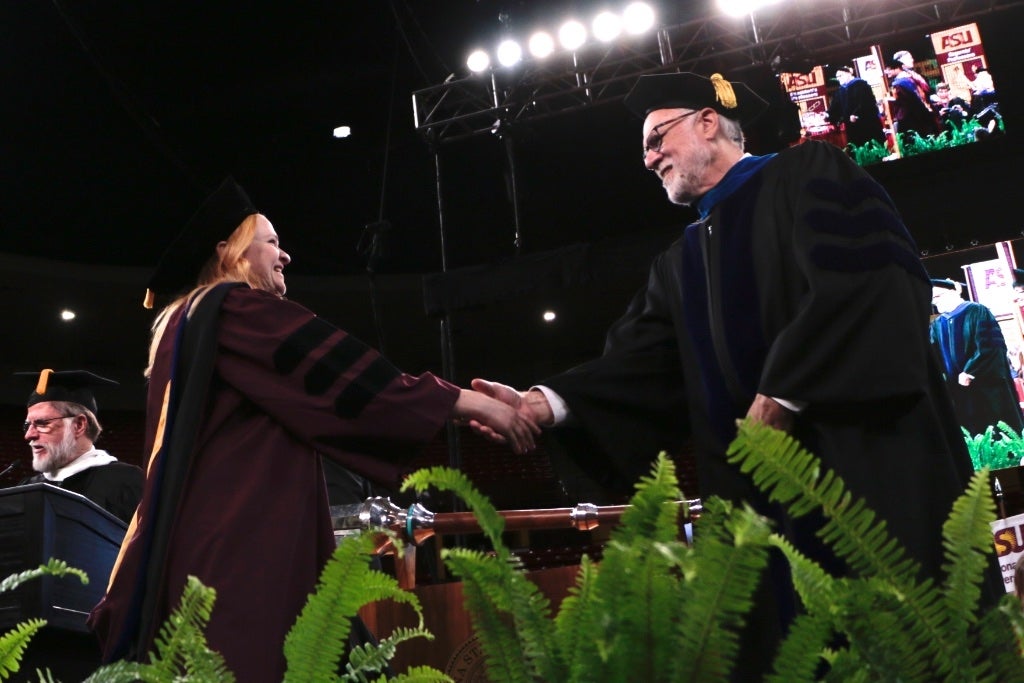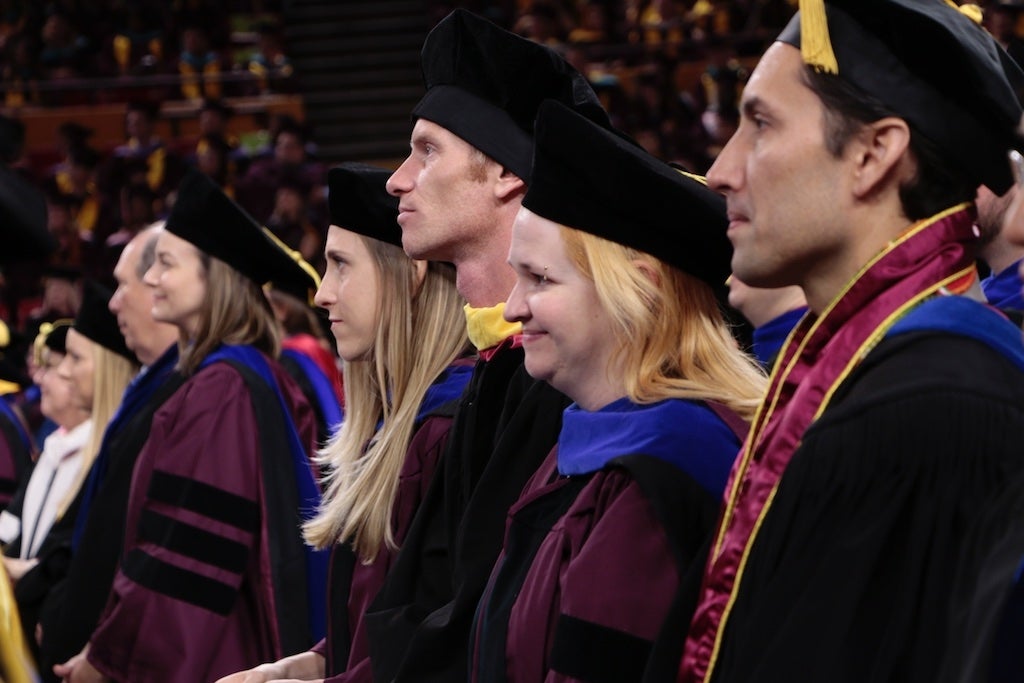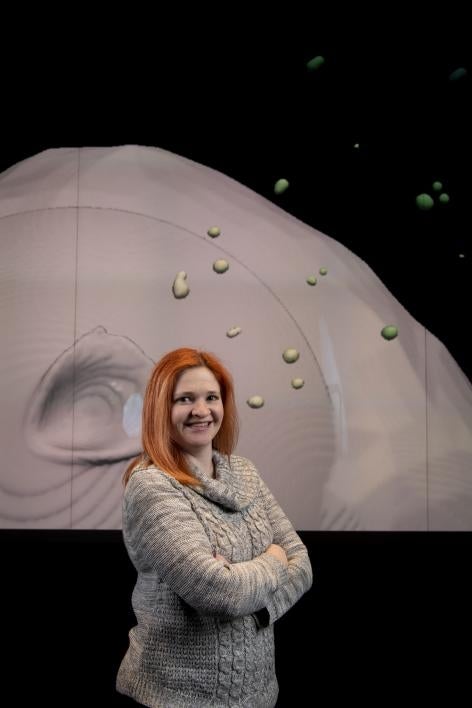Editor’s note: This is part of a series of profiles for spring 2019 commencement.
Wendy Caldwell grew up in Hendersonville, Tennessee, home to numerous musicians, such as Johnny Cash, Roy Orbison and Taylor Swift. Surrounded by music, she loved dance, choreography — and mathematics.
Although a strong mathematics student, she was forced to drop out of college due to a sudden-onset health condition that left her bedridden and financially strained. Fourteen months later, her medical bills forced her to file for bankruptcy. Graduate school was not even on her radar.
Slowly, things began to change. Caldwell began seeing an acupuncturist to treat her musculoskeletal condition. She moved into her dad’s basement to save money, and she sought help for her depression and anxiety. Even though she had been told that she would never walk again, she persevered to not only walk but also return to dance performance, which she loved.
She transferred her college credits to the University of Tennessee and worked four jobs to pay for her undergraduate degree. Several professors encouraged her to get involved in research. She then started thinking about graduate school in applied mathematics.
In the summer before completing her bachelor's degree, she came to Arizona State University to participate in the Mathematical and Theoretical Biology Institute (MTBI), and to see if she could survive the hot desert summer. She was impressed with the vast research areas of the faculty on campus, and especially ASU’s strong research in mathematical biology.
During MTBI, she met and worked with Stephen Wirkus and Erika Camacho, and she knew she wanted to continue working with them. ASU quickly became her top choice for grad school.
She also met an effective acupuncturist who treated her weekly. Although she received fully funded offers from several other schools, she ultimately chose Arizona State because it was the total package: full funding, a strong reputation for research, outstanding mentorship, availability of treatment for her condition, and excellent year-round weather. In the fall of 2014, Caldwell began her PhD journey at the age of 31.
In the summer of 2015, she traveled to Los Alamos National Laboratory (LANL) for the first time. She participated in a Computational Physics Summer Workshop and worked on shock wave propagation through porous solid materials. This sparked her interest in planetary science applications of mathematics.
The following summer she returned to LANL as a student in the Data Science at Scale Summer School. She worked on using Centers for Disease Control and Prevention internet traffic data to create near real-time predictions of the influenza season. Her work was recognized as one of the top three at the LANL Student Symposium representing work under the Associate Directorate for Threat Identification and Response. Later that fall, Caldwell suffered a traumatic brain injury and was unable to work on research for five months because of a severe concussion.
Caldwell saw how mathematical models can address a wide range of subjects, and she was particularly interested in problems that could not be addressed properly through experimentation. The first part of her doctoral dissertation focuses on the Vicodin epidemic in the U.S. Her mathematical modeling shows that prevention is more cost-effective than treatment or intervention at the addiction stage. Her research earned her Best Graduate Poster honors at the American Mathematical Society Poster Conference.
In fall of 2017, Caldwell returned to LANL as a full-time graduate research assistant to finish the planetary science applications of her dissertation, specifically asteroid impacts. Her project focused on modifying existing LANL-developed hydrodynamics code to model impact cratering events. She used LANL’s fast supercomputers for complex simulations that showed results in hours rather than weeks.
As a result of this work, Caldwell was awarded a $50,000 Emerging Ideas Research and Development grant from the Center for Space and Earth Sciences (CSES) Program to pursue simulations of asteroid 16 Psyche. The primary goal of the project is to determine the likely composition, porousness and material of 16 Psyche through comparison of simulated and measured values of the two craters on the asteroid’s surface. Her manuscript about this work has been accepted in the Journal of Verification, Validation and Uncertainty Quantifications, one of several journals by the American Society of Mechanical Engineers.
In addition to the CSES grant, Caldwell won the ASU Graduate College Completion Fellowship for the spring 2019 semester, which included one semester stipend, tuition and health insurance. She also won the Graduate Research Award from the School of Mathematical and Statistical Sciences and the Outstanding Research Award from the Graduate and Professional Student Association.
“Since starting grad school, she has done research in computational physics, data science, epidemiology, computer science, planetary science and materials science. She has one manuscript accepted, one under revision, another under review and six others in progress,” said Wirkus, Caldwell’s adviser.
“Her work will have tremendous impact in two vastly different areas. Specifically, NASA has a planned mission to Psyche that will collect data, so it would benefit the planetary science community to know her simulation results before that mission launches,” he explained. “And her results on the Vicodin model will have a dramatic impact on the increasingly alarming opioid problem in the U.S.”
Caldwell received her PhD in applied mathematics from the School of Mathematical and Statistical Sciences this May. We asked her a few questions about her ASU journey.
Question: What do you like most about mathematics?
Answer: I love that mathematics can address problems in a variety of fields and applications. I have always been someone with interests in a variety of areas, and math allows me to apply my skills to many different kinds of problems. Over the past five years, using my background in math, I’ve been able to do research on prescription drug abuse, nowcasting influenza with internet data, algorithmic development for reconstructing large data sets, hydrocode verification and validation, and impact cratering and solid mechanics on asteroid 16 Psyche. Being able to apply my skills to such a diverse range of problems is by far my favorite thing about math.
Q: Which professor taught you the most important lesson while at ASU?
A: Without a doubt, that would be my adviser, Stephen Wirkus. He talked me off the “math ledge” every semester, and that gave me the strength and courage to keep going. He taught me that graduate school is not just about being smart and doing well in courses. Perseverance is one of the biggest keys to success in graduate study.
Q: What is the best piece of advice you would give to those still in graduate school?
A: I would tell graduate students that everything they are feeling is normal. It is normal to feel stupid and to feel like an imposter sometimes. It is also normal to feel confident and able sometimes. It is normal to feel all of these things multiple times per day. Those in charge of admission to the program know what it takes to succeed, and they saw that potential in the applications of the students they chose to admit. It is important to focus on the end goal — the degree — when the current situation seems impossible or hopeless. Also, build your network. It will serve you well as you start and build a career.
Q: What was your favorite spot on campus, whether for studying, meeting friends or just thinking about life?
A: This is a toss-up between the patio outside Noble Library, where I would often get coffee and catch up with friends, and PEBW 240, the dance studio where I took contemporary ballet and postmodern contemporary to maintain a healthy work/life balance.
Q: What do you like to do in your spare time for fun?
A: I haven’t had a lot of spare time in graduate school, but when I do find myself with extra time (and I don’t need a nap), I like trivia, karaoke, cooking, dancing, choreographing, reading, going to movies and self-care activities like pedicures, massages and facials.
Q: What do you think is most misunderstood about math by the general public?
A: I think this is two-fold: 1) that mathematics is not useful in everyday life, and 2) that mathematicians are little more than human calculators. I often hear people say they never use math since leaving school, but that is simply not true. Not all math is arithmetic, and this is a common misconception. Along these lines, it’s also common for people to ask how many digits of π I know, or something along those lines. I think this stems from the idea that mathematics = arithmetic.
Q: What are your plans after graduation?
A: I plan to continue my work at Los Alamos National Laboratory by staying on as a postdoctoral researcher in computational planetary science, as well as other applications.
Q: Why were you originally interested in Los Alamos National Laboratory?
A: Los Alamos National Laboratory (LANL) is a place of cutting-edge research. The work done at LANL has quite literally changed the world, and we have not seen war on a global scale since World War II. World-class scientists devote their careers to protecting not only our nation's citizens but people all over the world, and this often comes at a professional cost that hinders their publication rates and job prospects outside of the laboratory. I find that to be incredibly noble.
Q: Why do you want to work at Los Alamos National Laboratory?
A: I want to work at LANL because it has the interdisciplinary collaborative atmosphere of a university coupled with the overarching mission of national security. This gives the work we do at the laboratory a higher purpose, and it feels good to be a part of that. We have tools and resources here that I would not have access to elsewhere. Our computational resources alone are some of the best on the planet, and having access to those resources really broadens the scope of the work I can do. Since I first came to LANL as a student fellowship guest in 2015, I have worked on projects in computational physics, planetary science, materials science, data science, mathematical biology and computer science. I have been able to make meaningful contributions in a variety of research areas, and LANL provides me with the right environment to explore my many research interests.
More Science and technology

ASU professor honored with prestigious award for being a cybersecurity trailblazer
At first, he thought it was a drill.On Sept. 11, 2001, Gail-Joon Ahn sat in a conference room in Fort Meade, Maryland.…

Training stellar students to secure semiconductors
In the wetlands of King’s Bay, Georgia, the sail of a nuclear-powered Trident II Submarine laden with sophisticated computer…

ASU startup Crystal Sonic wins Natcast pitch competition
Crystal Sonic, an Arizona State University startup, won first place and $25,000 at the 2024 Natcast Startup Pitch Competition at…






